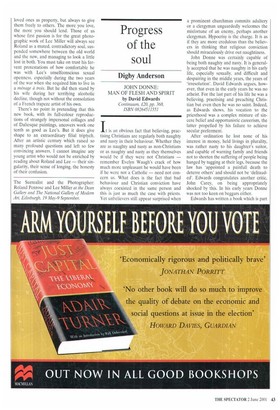Loving and lending friends and pictures
David Hare
ROLAND PENROSE: THE FRIENDLY SURREALIST by Anthony Penrose Prestel, £25, pp. 192, ISBN 3 791324926 Everyone believes their parents must have something interesting in the attic, but nobody has ever been able to prove it to quite such satisfying effect as Anthony Penrose. Just a few months after his mother's death in 1977, he was able to smother the memory of her own ferocious self-deprecation and defiantly open up an abandoned collection of boxes and trunks in the family farmhouse in Sussex, There he came upon the 40,000 negatives and 500 prints which
would posthumously establish Lee Miller's reputation as one of the great pioneering photographers of the 20th century.
In the two superbly illustrated books which followed, The Lives of Lee Miller and Lee Miller's War, Penrose detailed his mother's progress from her beginnings as a model in New York, through her arrival in Paris in 1923 as the object of Man Ray's sexual and photographic obsession, and right on past her unlikely heyday as the American war correspondent for the British fashion magazine Vogue. (Telegram from Dachau to her editor in London: 'I implore you to believe this is true.') Now Penrose has turned his attention to the less glamorous figure of his father, who is remembered — when he is remembered at all — as the rather austere English ambassador for the Surrealist movement, and as the man who persuaded the owner of the Academy Cinema in Oxford Street to lend his basement for the realisation of his own most treasured ambition: the foundation, in 1948, on unpromising British soil, of a permanent Institute of Contemporary Arts. The important thing, said Roland, was tO avoid the word 'museum'.
Born into a moneyed, high-minded Quaker family, Roland Penrose escaped Cambridge, architecture and a brief affair with George `Dadie' Rylands to spend the 1920s travelling across France discovering the delights of the Mediterranean, modernism and women. Intending to become a painter himself, he drifted, by sheer enthusiasm and without calculation, into becoming a collector of others. Soon after moving into a terraced house at 21 Downshire Hill, Hampstead in 1936, he was able to decorate it with examples of the work of Picasso, Braque, Miro, Tanguy, de Chirico, Brancusi, Giacometti, Tunnard, Magritte and Max Ernst. In the front garden, to the horror of the neighbours, he put Henry Moore's 'Mother and Child'. (The sculptor told him, 'If ever you get tired of this, change it, I will give you another one instead.') When, later, the young Lucian Freud wanted to borrow Picasso's 'Weeping Woman' from Roland's private collection in order to examine it more closely, Freud was lent the painting to carry home, unwrapped, on the tube.
Nothing ever seems as innocent as yesterday's avant-garde, and Surrealism itself, once considered so threatening and subversive, has been transformed by hindsight into a kind of sunlit, sybaritic lawnparty, given as a spontaneous celebration to mark Sigmund Freud's discovery of the power of the subconscious. Roland's considerable postwar achievements (when knighted, he called himself a 'Sir Realist') both as a leading biographer of Picasso and as the curator of the great Picasso, Ernst and Miro shows of the 1960s were always grounded in the personal friendships he had made in the days of the movement's early vitality, though he remained haunted and, to a degree, humiliated by his suspicion that he had been admitted to the club on his financial rather than his artistic merits. (There was certainly no shortage of acquaintances like Geoffrey Grigson and Peggy Guggenheim ready to tell him so.) By the time the war was over, so was Surrealism. As Andre Breton remarked to Bunuel, 'It is sad, my dear Luis, but it is no longer possible to scandalise anybody.' When the Cold War began and Picasso's friends and colleagues were being denied entry to Britain for the Sheffield Peace Conference in 1950, Picasso was complaining bitterly, 'And what can I have done that they should let me through?'
With the monumental brickhouse of Tate Modern now squatting over the choppy grey Thames, it seems timely to publish such a modest and affectionate book about one half of the couple who took as gospel the Surrealist injunction never to treat your
loved ones as property, but always to give them freely to others. The more you love, the more you should lend. Those of us whose first passion is for the great photographic work of Lee Miller will always see Roland as a muted, contradictory soul, suspended somewhere between the old world and the new, and managing to look a little lost in both. You must take on trust his fervent protestations of how comfortable he was with Lee's unselfconscious sexual openness, especially during the two years of the war when she required him to live in a ménage a trois. But he did then stand by his wife during her terrifying alcoholic decline, though not without the consolation of a French trapeze artist of his own.
There's no point in pretending that this new book, with its full-colour reproductions of strangely impersonal collages and of Daliesque paintings, uncovers work one tenth as good as Lee's. But it does give shape to an extraordinary filial triptych. After an artistic century which raised so many profound questions and left so few convincing answers, I cannot imagine any young artist who would not be enriched by reading about Roland and Lee — their singularity, their sense of longing, the honesty of their confusion.
The Surrealist and the Photographer: Roland Penrose and Lee Miller at the Dean Gallery and The National Gallery of Modern Art, Edinburgh, 19 May-9 September.











































































 Previous page
Previous page